By Vix Burgett-Prunty
China just dropped a bombshell on U.S. trade, a 34% tariff on all American goods, starting April 10, 2025. This move is retaliation for recent U.S. trade policies, but for Ohio, the impact goes deeper than just economics. It could reinforce systemic inequalities tied to white supremacy culture, where corporate profits are prioritized over workers, small farmers are left behind, and marginalized communities bear the brunt of economic shocks.
Let’s break down how this tariff will hit Ohio and why it’s another example of how trade wars disproportionately harm the most vulnerable.
National Archives, Washington, D.C. (12573155)
Ohio’s Farmers: Sacrificed for Corporate Agribusiness
Ohio is one of the top soybean producers in the U.S., with China as its biggest buyer. But with a 34% tariff, small and midsize farmers, many already struggling, could be pushed out of business.
Who really loses? Family farms, not agribusiness giants. When soybean prices crashed in 2018 (after China’s last tariffs), small farmers suffered most, while corporations like Cargill and ADM used their power to lobby for bailouts (Ohio Soybean Association, 2025).
White supremacy in agriculture? The system favors large, corporate-owned farms (often white-dominated) over Black, Indigenous, and small-scale farmers who lack the same access to subsidies and loans (Farm Bureau, 2025).
Federal aid isn’t equal. In 2018, most bailout money went to the biggest producers, leaving smaller farms, especially those owned by people of color, struggling to survive (USDA, 2025).
This tariff could accelerate farm consolidation, putting more land and power in the hands of a few wealthy agribusinesses, while pushing out marginalized farmers.
Manufacturing: Workers Pay the Price While CEOs Profit
Ohio’s auto and steel industries employ nearly 100,000 workers, many in union jobs. But tariffs don’t hurt CEOs, they hurt the workers.
Supply chain chaos = layoffs. When Canada retaliated in 2018, Ohio lost $1.1 billion in trade, and workers bore the brunt (Cleveland Fed, 2025).
Rare earth minerals are at risk, if China restricts exports (used in EVs and tech), Ohio’s manufacturing could stall, but executives will still cash in on stock buybacks.
Who gets left behind? Predominantly Black and Latino workers in manufacturing hubs like Cleveland and Toledo face the highest risk of job cuts (Economic Policy Institute, 2025).
Trade wars protect corporate profits, not workers. Instead of tariffs, we need policies that actually protect labor, like stronger unions and fair trade deals.
Consumers: Inflation Hits the Poor Hardest
Tariffs are essentially a tax on everyday people and low-income families will feel it most.
Projected cost: Ohio households could pay $1,200–$2,000 more per year for basics like food, electronics, and building supplies (Cleveland Fed, 2025).
Food insecurity could rise. Soybean tariffs mean higher prices for cooking oil, animal feed, and processed foods, hitting food-insecure communities hardest.
Housing crisis worsens as construction materials (like steel and aluminum) get more expensive, slowing affordable housing projects in cities like Columbus and Cincinnati.
Inflation from tariffs disproportionately harms Black, Latino, and working-class families, while wealthy investors profit from price surges.
Long-Term Damage: A System Built for the Elite
Trade wars don’t solve economic problems, they make inequality worse.
Farmers of color lose land without fair policies, small Black-owned farms (already declining due to historic discrimination) could disappear.
Workers lose jobs instead of reshoring jobs, tariffs often lead to automation, benefiting corporations, not workers.
Corporate lobbyists win because big agribusiness and manufacturers will push for bailouts, while everyday Ohioans foot the bill.
What’s the Alternative?
Fair trade, not just “free” trade deals that protect workers, not just profits.
Support small farmers by redirecting subsidies to Black, Indigenous, and family farms.
Tax the rich, instead of tariffs, make corporations and the ultra-wealthy pay their fair share.
Who Really Wins in Trade Wars?
China’s 34% tariff isn’t just bad for Ohio’s economy, it’s another example of how economic policies reinforce white supremacy culture: protecting the powerful while leaving everyone else behind.
If we want real change, we need to fight for an economy that works for all Ohioans, not just the wealthy few.
References
Ohio Soybean Association. (2025). Impact of China Tariffs on Ohio Agriculture.
Farm Bureau. (2025). Racial Disparities in Farm Subsidies.
USDA. (2025). Bailout Allocation and Small Farms.
Cleveland Federal Reserve. (2025). Inflation and Tariffs: Ohio’s Rising Costs.
Economic Policy Institute. (2025). Manufacturing Job Loss and Race.




